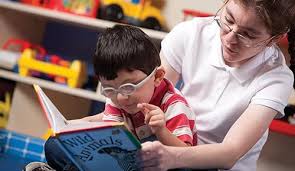
Authors: Laura M. Justice, Executive Director, SFCCCEC, Jessica A.R. Logan, CCEC Senior Research Scientist, Sonnur Işitan, Balıkesir Üniversitesi, Mesut Saçkes, Balıkesir Üniversitesi
Original Citation: Justice, L.M, Logan, J.A.R., Işitan, S., & Saçkes, M. (2016). The home-literacy environment of young children with disabilities. Early Childhood Research Quarterly, 37, 131-139. http://dx.doi.org/10.1016/j.ecresq.2016.05.002
Background: Young children with developmental disabilities often demonstrate delays in learning important early literacy skills, and as a result are often at a higher risk for future reading problems (Cabell, Justice, Zucker, & McGinty, 2009). Previous research has suggested that these delays in early literacy skills may reflect limited early learning opportunities in the home literacy environment (Light & Smith, 1993). This study asks: 1) To what extent are there are differences in the home-literacy experiences of children with and without disabilities? and 2) How are these experiences related to children’s early literacy skills?
Sample: In total, 692 preschool children participated in this study. Students were enrolled in 83 public Early Childhood Special Education (ECSE) classrooms. Just over half (57%) had a disability, and most had a general non-specific disability. Children’s caregivers completed a questionnaire on: 1) their family background; 2) beliefs regarding reading with their children; 3) their own reading habits; 4) how often children were read to; 5) whether they taught their child early literacy skills; and 6) their child’s interest in reading.
Results:
- There were no significant differences between children with disabilities and their peers in the amount of storybook reading that occurred in the home.
- There were no differences in the extent to which caregivers taught their children explicit early literacy skills.
- However, caregivers of children with disabilities reported that their children had lower motivation to engage with print.
- Children with disabilities who displayed less interest in engaging with print also demonstrated lower early literacy skills.
Discussion: This study suggests that the key difference between the home literacy experiences of children with and without developmental disabilities is the child’s interest in engaging with print. It may be important to gage children’s levels of print interest during book reading and possibly provide opportunities to increase it. For example, caregivers can offer storybooks that feature manipulative components (e.g. flaps to open), which have been shown to be more engaging to children with disabilities (Kaderavek & Pakulski, 2007). Overall, this study points to the need for further research into child-initiated home literacy experiences, particularly for children with disabilities.
References: Cabell, S.Q., Justice, L.M., Zucker, T.A., & McGinty, A.S. (2009). Emergent name-writing abilities of preschool-aged children with language impairment. Language, Speech, and Hearing Services in Schools, 40(1), 53-65. http://dx.doi.org/10.1044/0161-1461(2009/07-0099)
Kaderavek, J.N., & Pakulski, L.A. (2009). Mother-child story book interactions: literacy orientation of pre-schoolers with hearing impairment. Journal of Early Childhood Literacy, 7(1), 49-72. http://dx.doi.org/10.1177/0022219413510179
Light, J., & Smith, A.K. (1993). Home literacy experiences of preschoolers who use AAC systems and of their nondisabled peers. Augmentative and Alternative Communication, 9(1), 10-25. http://dx.doi.org/10.1080/07434619312331276371

